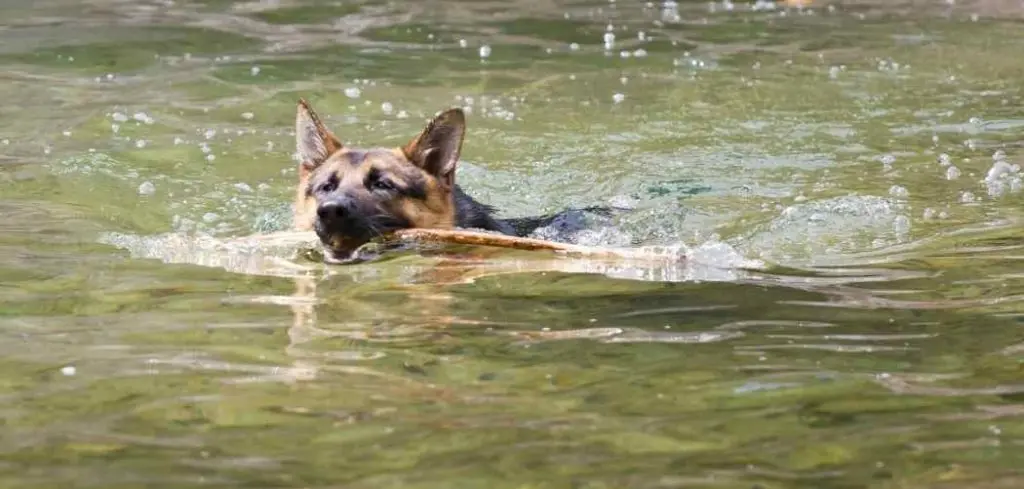
Do German Shepherds like water? It seems to be a universally accepted fact that most dogs like water. This, however, is not true. There are several reasons why a dog may dislike or fear water. Some dogs just aren’t interested in swimming at all.
So which category do German Shepherds fit into? Well, they can fall into either. Personality has a big effect, as does previous experience and external factors such as other dogs or people.
German Shepherds were bred for hunting, herding, and guarding, so they were never exposed much to water. Any natural affinity they have comes from their personality. Some German Shepherd Dogs like water, while others will be cautious of it. Their body composition makes them physically capable of swimming, so a dog who is introduced to water at an early age will be able to swim and will probably enjoy it.
Table of Contents
When German Shepherds Like Water
Although every dog has their own personality, their experience of water during puppyhood has a big influence on how they view water as an adult dog. German Shepherds who are introduced to water at an early age and in a positive environment, will either grow to love water or at least have no dislike or fear of it.
Most puppies get treats during bath time as a way to keep them calm. This forms a positive association, so as the dog ages, they begin to enjoy being in the water and will even seek it out on walks. Seeing other dogs playing and swimming in water will be a big temptation for your dog. They will want to investigate and join in the fun.
Some dogs have a natural affinity with water and will enjoy swimming even if they haven’t had much experience of being bathed as a puppy. In the summer months, many dogs will go for a paddle or a swim to cool off. Dogs who are normally not interested in water will also show interest in water during the warmer months.
When German Shepherds Dislike Water
A puppy who has never been bathed or has not been exposed to water in a gentle way will develop a fear of water. They will usually stay away from water during walks. They will also not want to go for walks if it is raining.
Dogs who are anxious around water will try to avoid bath time by hiding or resisting when you try to lead them to the bathroom. A dog with this kind of aversion can be taught to be comfortable around water with lots of gentle praise and treats. Showing them that there is no negative consequence to getting wet helps to alleviate a lot of their fear.
For a small percentage of dogs, a previous bad experience develops their fear of water. It may be that they fell in a pool as a puppy or got stuck in a strong current at the beach. Any situation where getting wet was a sudden occurrence can form a negative connection for your dog.
These dogs tend to have a much stronger fear of water and will react more dramatically if you try to bathe them or force them to get into the water. With lots of gentle and reassuring practice, they can learn to accept water, but it will take a lot of patience.
Tips to Introduce Your Dog To Water
There are lots of different approaches you can take to safely introduce your German Shepherd to water and swimming.
Be Patient: not all dogs have an affinity to water. For some, new situations are scary. You must never force your dog into the water. Allow them to approach and check it out on their own. It may take several attempts before they are comfortable enough to get their paws wet.
Get In With Them: our dogs look to us to lead and take control of new situations. If your dog sees you calmly getting into the water, it shows your dog that the water is safe and has nothing to be afraid of.
Start Small: it is unrealistic to expect your dog to jump straight into a lake the first time they see water. Try setting up a small doggy pool or kiddie pool in your yard. With the water only deep enough to cover their feet, it is much less intimidating than a deep swimming pool.
Lots of Praise: verbal praise and encouragement will really help to relax your dog and make them more comfortable with getting into the water. Praise them just for stepping close to it, even if they don’t get in. the more positive experiences they have, the easier it will be to get them used to the water.
Swimming Lessons: yes, you read that right. Dogs can take swimming lessons! There are lots of facilities that offer swimming lessons for dogs, as well as hydrotherapy sessions. You can also search for outdoor dog pools. Some facilities offer doggy pool parties for friendly dogs!
Meet Up With Other Dogs: if your dog sees other dogs happily getting into the water and swimming, your dog will be tempted to follow. If other dogs can do it, it must be safe. Remember to encourage them verbally but never physically put them in the water. Let them go in on their own.
Visit The Beach: the beach is a great way to introduce your dog to the water. The beach is a fun place to be, with lots of different smells, the texture of the sand, and other dogs. Since the ocean is very shallow at first, this tends to be more reassuring and appealing for dogs who have never experienced water before. It also makes it easy for you to get paddling so your dog can follow you into the water.
Life Jackets: for dogs who have never been in the water before, life jackets are a great idea. If you take your dog to swimming lessons, the instructor will fit your dog with a life jacket for their first couple of sessions. This allows the dog to get used to the sensation of floating and swimming without risking them going under the water. You can purchase life jackets for your dog from online stores or specialist companies. You should put one on your dog the first time they visit the beach or a lake, just for safety. Once they are used to swimming, you can allow them to swim without the life jacket.
Is Swimming Good For My German Shepherd?
Absolutely. Swimming is actually one of the best exercise options for any dog. When dogs swim they use their legs to power their movement and their tail as a rudder to change direction. Swimming is a full-body workout and is particularly good for dogs who need to lose some weight.
Due to the buoyancy of the water, swimming is very low impact, which means it does not put pressure on the joints as running does. Overweight dogs or those suffering from joint-related conditions, will find swimming beneficial for their health as well as being fun.
Swimming is a like a cardio workout. Your dog is constantly moving their legs, which will increase its heart rate. This in turn helps to boost circulation and increase stamina. Swimming also helps to strengthen a dog’s lung capacity.
During the warmer times of the year, swimming is a great way for your dog to keep cool. They can be out playing in the water on hot days without the risk of heat stroke. If your dog has been for a long walk and it panting heavily, you can encourage them to sit or lie down in a kiddie pool to cool off. Most pet stores now sell doggy pools. They are made of a more durable material that is less likely to rip if a dog catches its claw on the lining.
Some dogs are prone to depression, just like us humans. The act of swimming triggers the brain to release certain chemicals. These chemicals make the dog feel good, almost like a happy drug. It is the same reason we feel good after a gym workout or a run.
Final Thoughts
Whether you have a confident puppy or a nervous one, the most important thing to remember is to be calm and patient. Puppies naturally want to follow, so you can use this to your advantage when introducing them to water. Start with a shallow pool and encourage them to follow you in. reward them with lots of praise and a treat.
Older dogs or those you have rescued from a shelter may have had bad experiences with water. You must never force a dog to go into the water. Picking them up and carrying them to the water will only make them more nervous about going in. The choice to enter the water must be theirs.
There are lots of different training methods to introduce your dog to the water. If one method doesn’t work, try a different approach. Go to your local beach, lake, or dog pool and speak to other dog owners. Ask them how they introduced their dog to the water. Your dog may simply need to see other dogs swimming to feel comfortable trying it for themselves.
Make it fun! If a dog has a positive experience with something, they are more likely to want to do it again. Try playing games your dog enjoys such as fetch, frisbee, or tug. Start near the water and gradually move closer. The beach is a great place to do this.
Your dog’s body language will let you know if they are happy. If they show interest, move towards the water and aren’t running away from it, then you will find getting them used to water relatively easy. As soon as your dog shows nervous body language, allow them to move away.
Another article you may enjoy: Can German Shepherds eat strawberries?

